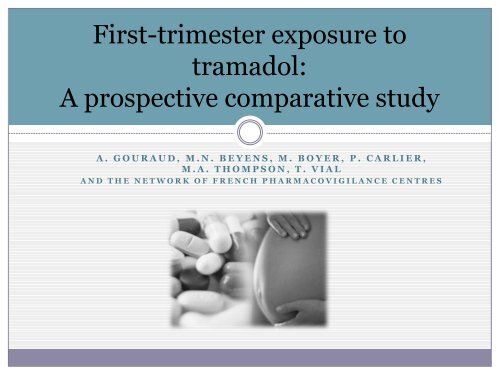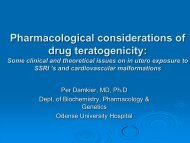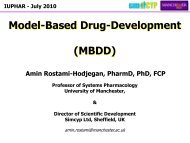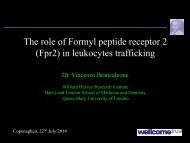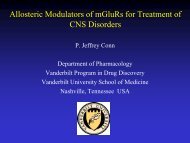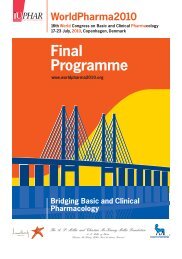Diapositive 1 - WorldPharma 2010
Diapositive 1 - WorldPharma 2010
Diapositive 1 - WorldPharma 2010
Create successful ePaper yourself
Turn your PDF publications into a flip-book with our unique Google optimized e-Paper software.
First-trimester exposure to<br />
tramadol:<br />
A prospective comparative study<br />
A . G O U R A U D , M . N . B E Y E N S , M . B O Y E R , P . C A R L I E R ,<br />
M . A . T H O M P S O N , T . V I A L<br />
A N D T H E N E T W O R K O F F R E N C H P H A R M A C O V I G I L A N C E C E N T R E S
Tramadol during pregnancy: what is known?<br />
• Tramadol is a synthetic analogue of codeine use to treat<br />
moderate to severe pain.<br />
• Animal teratogenicity studies were negative in all tested<br />
species whatever the dose<br />
• In pregnant women:<br />
◦ Shown to be safe when used during labor.<br />
◦ No documented studies on the safety of tramadol in early pregnancy<br />
Other analgesics such as codeine or propoxyphene should be<br />
preferred during the first trimester of pregnancy.<br />
• Is tramadol a potentially safe alternative in case of<br />
propoxyphene withdrawal ?
A French collaborative study<br />
• Prospective comparative study using data collected by<br />
participating French pharmacovigilance centers.<br />
• Objectives:<br />
◦ Primary objective:<br />
To evaluate the rate of (major or minor) congenital malformations<br />
following exposure to tramadol during early pregnancy.<br />
◦ Secondary objectives:<br />
<br />
<br />
To evaluate the rate of spontaneous or voluntary abortions<br />
To describe the characteristics of neonates
Method<br />
● Inclusion criteria<br />
◦ Exposure to tramadol during embryogenesis (weeks 4 to 12 after LMP)<br />
◦ Only pure prospective cases with data collected before week 22, i.e<br />
before the level II US.<br />
● Data collection was performed by phone or mail<br />
◦ At the time of request for risk evaluation.<br />
◦ Within 2-3 months after the expected date of delivery.<br />
● Control group:<br />
Healthy women counseled after a non-teratogenic exposure.<br />
● Data collected from 1997 to 2009
Matching<br />
1 exposed woman 2 control women<br />
Age ± 2 years<br />
Matched for:<br />
Gestational age at time of first request ± 1 week<br />
Nearest calendar date
Maternal baseline characteristics<br />
Exposed<br />
N= 146<br />
Controls<br />
N = 292<br />
p value<br />
Maternal age<br />
(years: mean ±SD)<br />
Gestational age<br />
(weeks after LMP)<br />
31.1 ± 5.5 30.8 ± 5.1 0.7<br />
9.5 ± 4.5 9.7 ± 4.5 0.7<br />
Previous history of<br />
spontaneous abortion<br />
19.4%<br />
(/108)<br />
15.6%<br />
(/263)<br />
0.4<br />
Gestity<br />
(mean ±SD)<br />
1.71 ± 1.77 1.33± 1.32 0.023<br />
Parity<br />
(mean ±SD) 1.24± 1.37 0.98± 1.02 0.049
Characteristics of exposure<br />
Indications or purpose :<br />
Low back pain: 34.3%<br />
Post-operative pain: 15.7%<br />
Not stated: 31.1%<br />
Others: 18.9% including<br />
• 4 Suicidal attempts<br />
• 1 Maternal addiction<br />
Mean daily dose (n=79) :<br />
188 ±171 mg<br />
Tramadol-only exposure:<br />
17%<br />
50<br />
45<br />
40<br />
35<br />
30<br />
25<br />
20<br />
15<br />
10<br />
5<br />
0<br />
Treatment duration (n=119)<br />
45.6%<br />
21.4%<br />
20.4%<br />
12.6%<br />
Exposure between 0 and 7<br />
weeks : 77.5%<br />
single dose<br />
2-7 days<br />
7-30 days<br />
>30 days
Outcome:<br />
Elective or medical abortion<br />
Exposed<br />
Elective abortion: 9.6% (14)<br />
Medical abortion: 2.7% (4)<br />
p=0.01<br />
Control<br />
Elective abortion: 3.4% (10)<br />
Medical abortion: 0.7% (2)<br />
Statistically more abortions in exposed group than in control group.<br />
Medical abortion:<br />
‣ Exposed group (4):<br />
• 3 because of fetal anomalies<br />
-2 Down’s syndrome<br />
- 1 polyskeletal malformation<br />
• 1 because of severe maternal disease<br />
‣ Control group (2): 2 Down’s syndrome
Spontaneous abortion<br />
Exposed: 21 (14.4%)<br />
Control: 10 (3.4%)<br />
p
Live births<br />
Exposed<br />
Control<br />
Live birth<br />
108 (74%)<br />
3 sets of twins<br />
267 (91%)<br />
5 sets of twins<br />
Malformations<br />
(major and minor)<br />
5/104 (4.8%)<br />
Major: 2<br />
Minor: 3<br />
15/261 (5.7%)<br />
Major: 4<br />
Minor: 11<br />
RR= 0.84<br />
(IC 95% : 0.31-2.24)<br />
Gestational age<br />
(weeks after LMP)<br />
39 ± 2.4 39 ± 2.9 p=1<br />
Prematurity rate<br />
(
Major congenital malformation<br />
(chromosomal anomalies excluded)<br />
Malformation<br />
Hydronephrosis<br />
Tramadol<br />
exposure<br />
Up to 9 weeks<br />
after LMP<br />
Other risk<br />
factor or drug<br />
exposure<br />
during<br />
embryogenesis<br />
Paternal exposure<br />
to methotrexate<br />
Camptodactily and<br />
skeletal anomalies<br />
Up to 19 weeks<br />
after LMP<br />
Maternal low<br />
dose methotrexate<br />
therapy (RA) until<br />
19 weeks<br />
Medical abortion
Neonatal outcome: withdrawal syndrome<br />
• Neonatal withdrawal symptoms were reported in two neonates<br />
exposed during the whole pregnancy<br />
◦ A premature female (2,110 g) delivered at 36 weeks from a tramadoladdicted<br />
mother (daily dose of tramadol ≥300mg) experienced :<br />
transient neonatal hypoglycemia at H2<br />
an episode of seizure at H48 and myoclonic movements during 48h (normal<br />
EEG)<br />
◦ A full-term male (3,490g) delivered at 39 weeks from a mother treated<br />
for headache with a maternally reported daily dose of 50mg, experienced<br />
irritability and hyperexitability during his first days of life.<br />
• First description in 1997 (Meyer et al.). Since then at least 2<br />
others published reports involving premature newborns in 2<br />
cases and with a mean maternal daily dose of >350mg.
Conclusion<br />
Main limitation : relatively small size sample<br />
Main results :<br />
• Exposure to tramadol does not appear to be associated with an<br />
increased risk of MCM, low birthweight or prematurity.<br />
• Short exposure appears as a safe alternative to propoxyphene for the<br />
management of severe pain during the early stage of pregnancy.<br />
• High daily dose and/or exposure throughout pregnancy should be<br />
taken into account owing to the risk of neonatal withdrawal symptoms.


